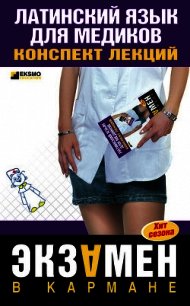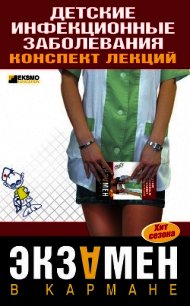Английский язык для медиков: конспект лекций - Беликова Елена (книги хорошего качества TXT) 📗
Pulmonary surfactant: Pulmonary surfactant is a phospholipid (comprised primari ly of dipalmitoyl phosphatidylcholine) synthesized by type II alveolar epithelial cells. Surfactant reduces surface tension, thereby preventing the collapse of small alveoli. Surfactant increases the compliance of the lung and reduces the work of breathing.
Surfactant keeps the alveoli dry because alveolar collapse tends to draw fluid into the alveolar space. Surfactant can be produced in the fetus as early as gestational week 24, but is synthesized most abundantly by the 35 th week of gestation. Neonatal respiratory distress syn drome can occur with premature infants, and results in areas of atelec-tasis, filling of alveoli with transudate, reduced lung compliance, and V/Q mismatch leading to hypoxia and CO2 retention.
New words
surface tension forces – поверхностные силы напряжения
liquid – жидкость
proximity – близость
adjacent – смежный
large – большой
intermolecular – межмолекулярный
to stabilize – стабилизироваться
surface – поверхность
to produce – производить
side – сторона
weak – слабый
greater – больше
distance – расстояние
between – между
phase – фаза
tension – напряженность
spherically-curved – сферически-кривой
lining – выравнивание
inward – внутрь
toward – к
curvature – искривление
spherical – сферический
similar – подобный
soap – мыло
inner – внутренний
to exert – проявить
interconnected – связанный
something – что-нибудь, что-то
everything – все
Употребление something, anything, nothing или everything
1. Утвердительная форма:
I can see something on the table.
2. Отрицательная форма:
I can see nothing on the table. I cannot see any thing on the table.
3. Вопросительная форма:
Can you see anything on the table?
Вставьте something, anything, nothing или everything.
1… is all right, the patient is much better today.
2. Is there… interesting in the programme of the concert?
3. I could see…: it was quite dark.
4. Give me… to drink.
5. I didn't take any money with me, so I couldn't buy…
6. My new eyeglasses are very good, I can see… now.
7. I saw… near the wood that looked like a tent.
8. Give me… to read, please.
9. I don't know… about your town. Tell me… about it.
10. Please give me… warm: it is cold here.
11. I understand… now. Thank you for your explanation.
12. There is… white in the box. What is it?
13. Is there… that you want to tell me?
14. Where is the book? – It is on the table. – No, there is… there.
15. I know. about it.
16. Tell me. about your family.
Answer the questions.
1. What forces serve to stabilize the liquid?
2. What does the liquid air produces?
3. Where are the liquid – air forces strong and weak?
4. Why are the liquid – air forces strong and weak?
5. What does the surface tension cause?
6. Where the liquid lining layer tend to be pulled?
7. In what manner does the spherical surface of the alveolar liquid lining behave?
8. What creates a greater pressure inside than outside the bubble?
9. Where interconnected alveoli of different sizes could lead?
10. What is a pulmonary surfactant?
Make the sentences of your own using the new words (10 sentences).
Make your own sentences using something, anything, nothing everything (10 sentences).
Find one word, which is a little bit different in meaning from others (найдите одно слово, которое немного отличается от других по смыслу):
1) a) eyelashes; b) lips; c) eyelid;
2) a) skull; b) head; c) heart;
3) a) esophagus; b) vein; c) intestines;
4) a) knee; b) blood; c) vein;
5) a) capillaries; b) arteries; c) bones.
ЛЕКЦИЯ № 29. The nose
The respiratory system permits the exchange of oxygen and carbon dioxide between air and blood by providing a thin cellular membrane deep in the lung that separates capillary blood from alveolar air. The system is divided into a conduct ing portion (nasal cavity, pharynx, larynx, trachea, bronchi, bronchioles) that carries the gases during inspiration and expiration, and a respiratory portion (alveoli) that provides for gas exchange between air and blood.
The nose contains the paired nasal cavities separated by the nasal septum. Anteriorly, each cavity opens to the outside at a nostril (naris), and posteriorly, each cavity opens into the nasopharynx. Each cavity contains a vestibule, a respiratory area, and an olfactory area, and each cavity communicates with the paranasal sinuses.
Vestibule is located behind the nares and is continuous with the skin.
Epithelium is composed of stratified squamous cells that are similar to the contiguous skin.
Hairs and glands that extend into the underlying connective tissue constitute the first barrier to foreign particles entering the respiratory tract.
Posteriorly, the vestibular epithelium becomes pseudostratified, ciliated, and columnar with goblet cells (respiratory epithelium).
Respiratory area is the major portion of the nasal cavity.
Mucosa is composed of a pseudostratified, ciliated, columnar epithelium with numerous goblet cells and a subjacent fibrous lamina propria that contains mixed mucous and serous glands.
Mucus produced by the goblet cells and the glands is carried toward the pharynx by ciliary motion.
The lateral wall of each nasal cavity contains three bony pro jections, the conchae, which increase the surface area and pro mote warming of the inspired air. This region is richly vascularized and innervated.
Olfactory area is located superiorly and posteriorly in each of the nasal cavities.
The pseudostratified epithelium is composed of bipolar neu rons (olfactory cells), supporting cells, brush cells, and basalcells. The receptor portions of the bipolar neurons are modi fied dendrites with long, nonmotile cilia.
Under the epithelium, Bowman's glands produce serous fluid, which dissolves odorous substances.
Paranasal sinuses are cavities in the frontal, maxillary, ethmoid and sphenoid bones' that communicate with the nasal cavities.
The respiratory epithelium is similar to that of the nasal cavi ties except that it is thinner.
Numerous goblet cells produce mucus, which drains to the nasal passages. Few glands are found in the thin lamina propria.
New words
respiratory system – дыхательный аппарат
exchange – обмен
oxygen – кислород
carbon – углерод
dioxide – диоксид
cellular – клеточный
membrane – мембрана
deep – глубоко
capillary – капилляр
conduct ing – проведение
portion – часть
nasal cavity – носовая впадина
pharynx – зев
larynx – гортань
trachea – трахея
bronchi – бронхи
bronchioles – бронхиолы
inspiration – вдохновение
expiration – истечение
the paired – соединенный
nasal septum – носовая перегородка
anteriorly – раньше
nostril – ноздря
posteriorly – сзади
vestibule – вестибулярный
respiratory area – дыхательная область
olfactory area – обонятельная область
paranasal sinuses – параназальные пазухи
somebody – кто-нибудь, кто-то
Употребление somebody, anybody, nobody или everybody.




